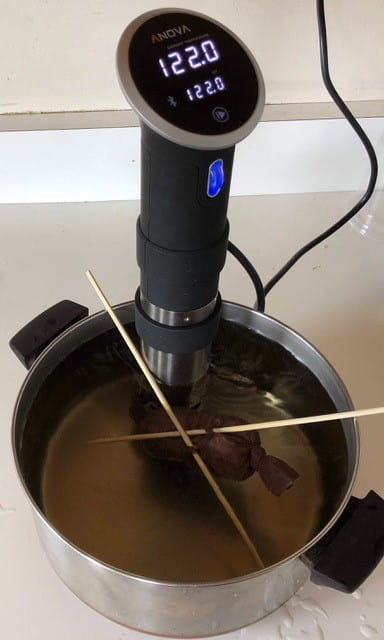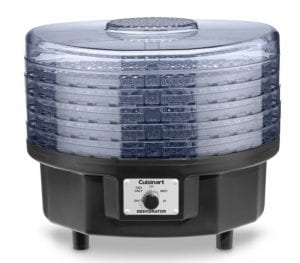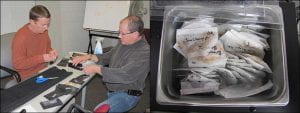Ensuring seed is not a source of pathogens causing diseases is an important first step in management. Some pathogens can be on or in seed. Fortunately, not all are capable of becoming associated with seed, but some important pathogens can. Seed-borne fungi include pathogens causing Septoria leaf spot of tomato and Alternaria leaf spot of crucifers. Diseases caused by seed-borne bacterial pathogens include black rot of crucifers, bacterial leaf spot of pepper, and bacterial canker of tomato. Contaminated seed can be an important first source of a pathogen on a farm or even a larger area (most notable example is the new downy mildew of basil in the US). Additionally, a severe disease outbreak can result when a pathogen is present at the start of plant growth. Pathogens able to get inside seed are especially difficult to manage because a surface disinfectant or fungicide treatment won’t affect them. Only heat treatment can get in to these pathogens.
What seed should be treated?
Likelihood that a particular batch of seed could benefit from hot water treatment depends on the crop, the pathogens affecting it, and the seed’s history. Most large-seeded crops (beans, cucurbits, and peas) cannot be effectively treated with hot water. Some pathogens that can be in seed occur more commonly than other seed-borne pathogens. For example, the pathogen causing black rot in crucifers is common in the northeast while the pathogen causing black leg has not been detected for years. Tomato, pepper, and crucifers are crops affected by some of the more common pathogens that can be seed-borne. Vegetable seed that can be treated are listed in Table 1 and diseases caused by pathogens that can be seed-borne are listed in Table 2. The seed’s history is another important consideration when deciding whether treatment is warranted. If you save your own seed or buy from a small producer, hot-water treatment may well be worthwhile. Some seed companies have the resources to minimize the chance of their seed becoming contaminated and also to test their seed. Producing seed where key pathogens do not occur and/or where environmental conditions are not favorable, such as in a greenhouse, are used to obtain clean seed. Determine the likelihood that pathogens could be present by asking your seed supplier if the seed was produced in a way to minimize potential for exposure to seed-borne pathogens and ask if the seed was tested for their presence. It is also important to find out if the seed has already been treated with hot water as treating again could adversely affect the seed. Pelleted seed cannot be treated, and primed or old seed should not be treated. Arugula and basil seed exude gelatinous material when treated which makes these seed very difficult to handle and plant afterwards.
How should seed be treated?
While hot-water seed treatment can be done effectively on a stovetop, it is much better to use a precision water bath or sous vide machine. Use a porous container to hold the seed such as organza bag, package made out of fiberglass window screen, or cone coffee filter. First put in a weight such as a quarter so the package will stay submerged in the water. Put identification information for the seed on a plastic pot label to go in fiberglass window screen packages or write directly on coffee filter. Partly fill container. Do not fill to the point that water will not be able to easily move into the center of the seed mass or that there will be stress on the seems of the coffee filter. Roll top of package over twice to close then staple shut with no gaps that could enable seed to escape. Attach a string to each package to facilitate moving the packages as needed in the bath and removing them from the bath. String from packages can be tied to a dowel rod. A large slotted cooking spoon also can be used to quickly remove seed packages from water at treatment end.
The temperature of water for treating seed varies from 118 to 125 F, depending on the crop, and the treatment period likewise varies from 15 to 30 minutes (see Table 1 below). Use a precision laboratory immersion thermometer to monitor temperature. Pre-heating seed at 100 F for 5-10 mins is recommended because putting seed and packages that are at room temperature directly into water at treatment temperature can cause the temperature to drop. After treatment put seed in container with cool water then dry (see next section). Equipment for treating seed, including precision water baths, were purchased for several locations in the mid-Atlantic and northeast regions through a project funded by the Northeastern IPM Center. Additionally, extension specialists were trained so that they could assist growers who want to hot-water treat their seed. Contact Meg McGrath to find the nearest location. It is important to use the appropriate treatment protocol for a crop to achieve control of pathogens without damaging the seed. Protocols are listed in Table 1.
 Sous vide (right) is a new machine that became available after the workshop training project. It is an immersion circulator precision cooker pod for cooking food in vacuum-sealed bags. Precise temperature control combined with water circulation makes it suitable for hot water seed treatment at a lower cost than scientific water baths. Several units are available on the web for less than $200. A unit used for treating seed is shown right and demonstrated in a video prepared by Amy Ivy (retired Horticulture Educator, Cornell Cooperative Extension Clinton County). Seed needs to placed in a porous container as done with water baths (not a sealed plastic bag used for food cooking) and also kept submerged during treatment.
Sous vide (right) is a new machine that became available after the workshop training project. It is an immersion circulator precision cooker pod for cooking food in vacuum-sealed bags. Precise temperature control combined with water circulation makes it suitable for hot water seed treatment at a lower cost than scientific water baths. Several units are available on the web for less than $200. A unit used for treating seed is shown right and demonstrated in a video prepared by Amy Ivy (retired Horticulture Educator, Cornell Cooperative Extension Clinton County). Seed needs to placed in a porous container as done with water baths (not a sealed plastic bag used for food cooking) and also kept submerged during treatment.
In a comparison of several methods to heat water for seed treatment done at MSU, the 3 sous vide tools performed the best. The onboarding temperature reading for these differed from a laboratory thermometer by up to 2.7 F at 120 F documenting the importance of using a laboratory thermometer.
See also Treatments for Managing Bacterial Pathogens in Vegetable Seed for guidelines for treating seed on a stovetop.
What to do after treating seed?

Immediately after treatment seed needs to be dried. Packages can be put in a vegetable dehydrator that has a fan only (no heat) setting. Packages with small quantities of seed can be laid out on paper towels. Larger quantities of seed should be removed from the package and spread out on paper towels.
It is recommended to sow seed soon after it has been dried because seed will imbibe some water during treatment which can prime it and hasten germination. While it is not recommended to keep hot-water-treated seed until the next season, no loss of germination was detected in 2021 with tomato seed treated in 2013.
Treating seed with hot water is one component of an integrated disease management program. Sometimes this procedure is not completely effective. But even when it is, achieving effective control of a disease typically necessitates implementing other practices targeting additional potential sources of the pathogen. Other practices to use include sanitation (greenhouse, planting materials, tomato stakes, etc. ) and crop rotation. Resistant varieties, fungicides, and water management will slow disease development. Specific practices to use vary with the pathogen.
Please note: while this is a well-documented procedure, any treatment done to seed after purchase voids any guarantees of the seed company.
History of black rot at Cornell and LIHREC: Hot water seed treatment protocol for crucifers was developed by Howe S. Cunningham when he was stationed at the Cornell University facility in Riverhead (then called the Long Island Vegetable Research Farm) from 1931 to 1952. At the time, crucifers were being grown widely on Long Island and black rot was a major disease impacting their production. This is thought to be the first use of hot water to kill pathogens in seed. See the eCommons article about H. S. Cunningham to learn more about him and his career.

Table 1: Hot-Water Seed Treatment Protocols
Printer-friendly .pdf versions of Tables 1 and 2.
Prepared by Margaret Tuttle McGrath, Cornell University, Long Island Horticultural Research and Extension Center, 3059 Sound Avenue, Riverhead, NY. mtm3@cornell.edu
Crop Temperature and time Reference
Brussels sprouts 122°F 25 minutes 1, 3, 4
Broccoli 122°F 20 minutes 1, 2, 3
Cabbage 122°F 25 minutes 1, 3, 4
Carrot 122°F 20 minutes 1, 2, 3
Cauliflower 122°F 20 minutes 1, 3, 4
Celeriac 118°F 30 minutes 3
Celery 118°F 30 minutes 1, 3
Chinese cabbage 122°F 20 minutes 1, 4
Collards 122°F 20 minutes 1, 3, 4
Coriander 127°F 30 minutes 4
Cress 122°F 15 minutes 1, 3, 4
Cucumber 122°F 20 minutes 1, 4
Eggplant 122°F 25 minutes 1, 3, 4
Kale 122°F 20 minutes 1, 3
Kohlrabi 122°F 20 minutes 1, 3, 4
Lettuce 118°F 30 minutes 1, 3, 4
Mint 112°F 10 minutes 4
Mustard 122°F 15 minutes 1, 3, 4
New Zealand Spinach 120°F 60-120 mins 4
Onion (sets) 115°F 60 minutes 4
Parsley 122°F 30 minutes 5
Pepper 125°F 30 minutes 1, 3, 4
Radish 122°F 15 minutes 1, 3
Rutabaga 122°F 20 minutes 3, 4
Shallot 115°F 60 minutes 4
Spinach 122°F 25 minutes 1, 3, 4
Sweetpotato (roots) 115°F 65 minutes 4
(cuttings, sprouts) 120°F 10 minutes 4
Tomato 122°F 25 minutes 1, 3, 4
Turnip 122°F 20 minutes 1, 3, 4
Yam (tubers) 112°F 30 minutes 4
125°F = 51.5 °C 122°F = 50 °C 118°F = 48 °C
125.6°F = 52 °C 131°F = 55 °C 132.8°F = 56 °C
1 Seed Treatments for Commercial Vegetables in Kentucky. by Bill Nesmith 7-94
2 Vegetable seed treatments, Department of Primary Industries and Regional Development’s Agriculture and Food, Government of Western Australia.
3 Hot Water and Chlorine Treatment of Vegetable Seeds to Eradicate Bacterial Plant Pathogens. Ohio State University Extension Fact Sheet. By Sally Miller and Melanie Ivey.
4 Vegetable Seed Treatment. University of Illinois Extension. RPD No. 915. March 1992. By Mohammed Babadoost.
5 Hot water treatment of vegetable seed – an alternative seed treatment method to control seed borne pathogens in organic farming. Journal of Plant Diseases and Protection 110(3):pp. 220-234. 2003. By Eva Nega et. al.
Note: Hot water treatment can be damaging or not practical for seeds of peas, beans, cucumbers, sweet corn, beets and some other crops. Some hybrid varieties of cauliflower may be damaged by the recommended treatment. From: Vegetable seed treatments
Table 2: Diseases of Vegetable Crops Caused by Seed-borne Pathogens
Printer-friendly .pdf versions of Tables 1 and 2.
Seed companies manage and test for many of the diseases listed here.
Prepared by Margaret Tuttle McGrath, Cornell University, Long Island Horticultural Research and Extension Center,
3059 Sound Avenue, Riverhead, NY. mtm3@cornell.edu
Crucifers (Cabbage, broccoli, cauliflower, Brussels sprouts, kale)
- Alternaria leaf spot
- Bacterial leaf spot (peppery leaf spot)
- Black leg
- Black rot
Carrot
- Alternaria leaf blight
- Bacterial leaf blight
- Cercospora leaf spot
- Crater rot and foliar blight
Celery
- Bacterial leaf spot
- Early blight (aka Cercospora leaf spot)
- Late blight (aka Septoria leaf spot)
- Phoma crown and root rot
Eggplant
- Anthracnose
- Alternaria early blight
- Phomopsis
- Verticillium wilt
Lettuce
- Anthracnose
- Bacterial leaf spot
- Lettuce mosaic virus
- Septoria leaf spot
- Verticillium wilt
Onion
- Botrytis neck rot
- Downy mildew
- Purple blotch
- Smut
- Stemphylium leaf blight
Parsnip
- Phoma canker
Pepper
- Anthracnose fruit rot
- Bacterial leaf spot
- Cucumber mosaic virus
- Pepper mild mottle virus
- Tobacco mosaic virus
- Tomato mosaic virus
Spinach
- Anthracnose
- Cladosporium leaf spot
- Cucumber mosaic virus
- Downy mildew (aka Blue mold)
- Fusarium wilt
- Stemphylium leaf spot
- Verticillium wilt
Tomato
- Alfalfa mosaic virus
- Anthracnose
- Bacterial canker
- Bacterial speck
- Bacterial leaf spot
- Cucumber mosaic virus
- Early blight
- Fusarium wilt
- Late blight (requires both mating types)
- Leaf mold
- Septoria leaf spot
- Tomato mosaic virus
- Verticillium wilt
- Double virus streak
Turnip, Rutabaga and Radish
- Alternaria leaf spot, brown spot
- Black rot
- Black leg
Table 3: Equipment for Hot-Water Treating Seed
Prepared Feb 2013 by Kris Holmstrom, Rutgers Cooperative Extension Vegetable IPM Program, Blake Hall Rm. 243, 93 Lipman Dr., New Brunswick, NJ 08901
and Margaret Tuttle McGrath, Cornell University, Long Island Horticultural Research and Extension Center, 3059 Sound Avenue, Riverhead, NY. mtm3@cornell.edu
- Carolina Biological Analog 10L bath: $734
- Fisher Thermo Scientific Precision Digital 5.5 L bath: $1088
- Thermometer from Carolina Biological Supply: $14.05 – Enviro-Safe Partial Immersion 12″ Thermometer (-20 to 150 C) Item #745443. Need 2.
- Enaly Ozone Generator (optional): $39.99 – Ozone is used to disinfect water when multiple seed lots are being treated in succession
- Supplies: distilled water, aquarium bubbler, roll of fiberglass window screen, coffee filters, weights (such as metal nuts or coins), plastic labeling stakes, and permanent markers.
See also:
More information/prepared by:
Margaret Tuttle McGrath
Associate Professor Emeritus
Long Island Horticultural Research and Extension Center (LIHREC)
Plant Pathology and Plant-Microbe Biology Section
School of Integrative Plant Science
College of Agriculture and Life Sciences
Cornell University
mtm3@cornell.edu
Prepared in collaboration with:
- Andy Wyenandt, Rutgers University, Cooperative Research and Extension
- Kris Holmstrom, Rutgers Cooperative Extension Vegetable IPM Program


